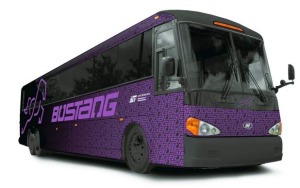Privatize the profits, socialize the losses. That’s what the Colorado Department of Transportation does with Bustang, the new state-owned intercity bus operation.
Bustang began operating July 13 with routes from downtown Denver north to Fort Collins, south to Colorado Springs and west to Glenwood Springs.
![]() The profits go to Ace Express Coaches, which operates the service for CDOT. It bought out the original contractor, Horizon Coach Lines, in April. It gets paid by the mile and its risk-free income will total $2.1 million this fiscal year. It pays the drivers but the state pays for the fuel.
The profits go to Ace Express Coaches, which operates the service for CDOT. It bought out the original contractor, Horizon Coach Lines, in April. It gets paid by the mile and its risk-free income will total $2.1 million this fiscal year. It pays the drivers but the state pays for the fuel.
Profits also presumably went to Motor Coach Industries, which sold CDOT 13 luxury buses for $579,000 apiece.
As for the operating losses, they are paid by all Colorado drivers through the FASTER program set up by the legislature in 2009. It increased vehicle registration fees an average of $41 per car per year, increased penalties for late registration and raised the fee on car rentals. The extra $200 million a year raised was advertised as going primarily to bridge repair and the highway infrastructure, but lawmakers simultaneously established a transit and rail division within CDOT and authorized FASTER funds to pay for “multi-modal transportation projects.”
Beginning last fiscal year, the Bustang program was authorized a subsidy of $3 million a year.
Projections for fiscal 2016, which began July 1, estimate fare revenue at just over $1 million, or 39 percent of costs. But the “worst case scenario” pegs revenue at $519,000, or just a 20 percent “fare box recovery ratio.” Besides the fees to Ace and fuel costs, expenses include CDOT management salaries, engineering and bus replacement costs.
After the first week of Monday-Friday operation between the Springs and Denver, the Colorado Springs Gazette reported that an average of just 43 passengers a day rode the bus north to Denver and another 43 south back to the Springs.
Since there are seven round-trips a day between the cities, that’s just six passengers on a 50-passenger luxury bus that features restrooms, bike racks, free wi-fi, power outlets and USB ports.
Mike Timlin, bus operations manager for CDOT, reported that total ridership between Denver and the Springs averaged 111 during the second week, or about eight passengers a ride. On the northern route to Fort Collins, which has six round-trips a day, the passenger total dropped from an average 112 a day the first week to 105 the second, or about 10 passengers a ride.
The fare is a very modest $12 one-way to Colorado Springs, $10 to Fort Collins and $28 to Glenwood Springs, which gets only one round-trip per day. This is a line designed to lose a lot of money just to take a few cars off the road and microscopically reduce air pollution.
The deal enjoyed by Ace Express amazes Corey Watson, who runs Front Range Shuttle. That’s an unsubsidized van service connecting Colorado Springs with Denver International Airport. He and his major competitor, Colorado Springs Shuttle, charge about $50 for a one-way ticket. Of course they don’t have taxpayers available to pick up the slack.
Says Watson of Bustang: “I’m thinking God, give me that gig and I’ll show you how to do it for half the price and fill up the seats.”
Bustang doesn’t connect directly to DIA — although airline passengers who have time to spare and don’t mind hassling their luggage can take the light rail from Denver’s Union Station once the east line to DIA begins service next year.
“I don’t see it lasting long,” Watson said of Bustang. “They’re trying to make it too convenient and too cheap, and it’s not going to keep funding itself.
“Give it a year, year and a half, and it’s gone,” he predicted.
That depends on the tolerance of the legislature. The Regional Transportation District is a regular money-loser and it doesn’t go away. Of course RTD is supposed to serve the poor. Bustang, on the other hand, serves those who are already able to commute between Colorado’s major cities.
Subsidized service between Denver and Colorado Springs has been tried before. The Springs subsidized a project known as Front Range Express from 2004 to 2012, when then Mayor Steve Bach shut it down because it was losing so much money. But CDOT presumably has deeper pockets than Colorado Springs.
The organizers do not lack ambition. According to Bustang’s written goals: “When successful, define viable expansion opportunities to grow into a network of bus routes connecting all of Colorado’s regional population, employment and activity centers.”
Heretofore, CDOT’s purpose has been to build and maintain an infrastructure over which private carriers and automobiles can function. Getting directly into the transportation business is an ominous sign.
Says shuttle operator Watson: Why is the state “kissing the rear ends” of so few people by “giving them such a cheap ride to Denver and making everybody else pay for it?”
Longtime Rocky Mountain News political columnist Peter Blake now writes twice a month for CompleteColorado.com. Contact him at pblake0705@comcast.net You may re-publish his work at no charge and without further permission; please give full credit to Peter Blake and www.CompleteColorado.com.


